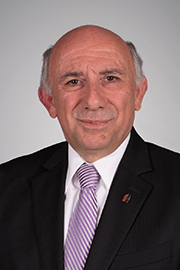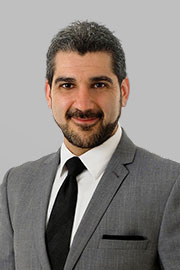- Mar/8/23 11:00:00 a.m.
As the member notes, ensuring that people can get to work, home, to medical services when they need to is more than just a luxury, it’s an essential service. We’ve heard from municipalities that they need our continued support after the last few challenging years, and we’ve been there to help them every step of the way.
To further support municipalities like the city of Brampton, we’re providing a one-time additional top-up of $80 million included in this year’s funding through the gas tax program. This will allow Brampton to accommodate its growing population and its increasing ridership while supporting economic growth in the city.
With more people returning to public transit, now is the time to invest in this critical infrastructure. Under the leadership of Premier Ford, we’re getting it done.
- Hear!
- Rabble!
- Mar/8/23 11:00:00 a.m.
Thank you to the minister for her response. A little louder for those around: “the great city of Brampton.”
It is welcome news that our government is so significantly investing in public transit. As we know, Brampton is one of the fastest-growing cities in the country. As more people turn to public transit, there is no disputing that now is the time to invest in this key infrastructure. The gas tax funding will help to ensure that communities have the resources they need to continue to deliver safe and reliable transit service. After 15 years of neglect from the previous Liberal government, backed by the NDP, it is essential now that all governments work collaboratively together to provide the quality of transit service that our communities so rightly deserve.
Speaker, can the minister please explain how our government is working with our municipal partners in supporting effective public transit?
- Hear!
- Rabble!
- Mar/8/23 11:10:00 a.m.
My question is to the Minister of Infrastructure. Under the leadership of the Premier and this minister, our government continues to deliver on our commitment to actively build infrastructure projects in communities across the province. The essential work being done by the province’s construction sector is critically important, yet they are encountering some challenges.
Within the current economic climate, it is all but certain that project costs could escalate due to a number of external factors. Nevertheless, it is essential that our government continues to prioritize projects that modernize our province’s public assets.
For the good of Ontario’s economic prosperity, job creation and the health and well-being of Ontarians, can the minister please explain how our government is investing in infrastructure projects while navigating the effects of global economic uncertainty?
- Hear!
- Rabble!
- Mar/8/23 11:10:00 a.m.
Thank you to the member for the question. Challenges such as inflation, rising costs of products, materials and supply chain disruptions are all real challenges that we’re facing here in Ontario, but also across the world. Our government, as a team, made a decision to face these challenges head on and forge ahead and continue to build Ontario.
Last week, we updated the P3 pipeline, which includes 38 major infrastructure projects which include an estimated value of $35 billion. Mr. Speaker, there’s some good news here, as two projects previously in pre-procurement now have gone to the market, where builders can make their submissions to Infrastructure Ontario: the Garden City Skyway twinning in Niagara, as well as the Ottawa Civic Hospital, one of our larger hospital expansion projects. Mr. Speaker, this is not a time to hesitate or delay. It is a time to build Ontario.
- Hear!
- Rabble!
- Mar/8/23 11:20:00 a.m.
Speaker, as the population continues to grow in my riding, it is critical that we build the necessary services to support their needs. Transit, highways, schools and long-term-care projects are important to the families and the people of my community. Under the previous Liberal government investments in expanding transit and improving health care facilities were not a priority. Sadly, the communities in my riding of Scarborough–Agincourt were left behind, as were many others across the province.
People deserve better and they are counting on our government to strengthen Ontario’s communities by investing in critical infrastructure. Can the minister please explain how our government is delivering on the promise of building public infrastructure that supports the local needs of communities?
- Hear!
- Rabble!
- Mar/8/23 11:20:00 a.m.
My question is for the Minister of Indigenous Affairs and Northern Development. There is so much to enjoy and discover in our communities across all of northern Ontario, Speaker. Unfortunately, the previous government, propped up by the NDP, failed to recognize the north for the importance of its vast resources as well as the ways in which northern communities contribute to our economic and cultural well-being here in Ontario. In short, they ignored opportunities to build infrastructure, to create jobs and to show the north the respect that it deserved.
This week, the Prospectors and Developers Association of Canada held their annual conference here in Toronto. This mineral exploration and mining convention draws large attendance from across the sector for the purposes of information-sharing and networking. Speaker, can the minister please provide information about how our government is partnering with and supporting northern Ontario businesses as part of this conference and all the opportunities that will stem from that?
While mineral exploration and mining are a key focus when it comes to opportunities in northern Ontario, our government must continue to ensure that our communities remain strong. Our northern communities deserve support in order to build the capacity that is needed to deal with the growth that comes from new and emerging mineral extractions. Speaker, can the minister please explain how the prospectors and developers association convention was an opportunity to better showcase the central role and importance of northern Ontario?
- Hear!
- Rabble!
- Mar/8/23 3:10:00 p.m.
- Re: Bill 71
Bill 71 obviously requires roads and infrastructure. The Premier once said that he would get on the bulldozer himself, but that clearly is not going to happen to build the road to the Ring of Fire. In fact, those comments are fairly damaging to the trust that some of the companies have been working on with First Nations.
I do want to quote Neskantaga First Nation Chief Wayne Moonias. He said, “We intend to defend our rights, our homeland, our river system, even if it costs us our lives.” Chief Moonias has also vowed that his community will prevent the building of a road to the Ring of Fire even if it means direct confrontation with the authorities.
Indigenous opposition has a long history now with this government because you’re only consulting with two of the First Nations as it relates to the Ring of Fire. Can the member from Malton tell the House how dangerous, how damaging it is when you are very selective in your consultations with First Nations and talk about the lawsuits and the legal action that will happen because you have not done your due diligence as a government as it relates to Indigenous peoples in Ontario?
- Hear!
- Rabble!
- Mar/8/23 3:10:00 p.m.
- Re: Bill 71
I am pleased to be able to stand in this House and add what I hope are my thoughtful comments on Bill 71, Building More Mines Act. I’m standing here as the official opposition critic for infrastructure but also as an Ontarian who knows that there are a lot of pieces that interconnect in this province. I am proud to represent Oshawa, and the automotive industry is a huge part of Oshawa’s story, of its history and of its future, and there’s that important interconnection when we’re talking about mining, about critical minerals and what those mean to the EV industry, to the future of various technologies. So I’m looking forward to taking this time and doing a little bit of a sharing lesson with folks at home, because I had to do some—it was like science class in preparation for this presentation.
But something else—and this is just a frame of reference for folks, because we are fortunate to come to this Legislature from all across the province, and different experiences. Some on our benches we’ve learned from through the years about their time in mining or in various industries. In Oshawa, I was at a hockey game, actually, and I got to meet someone who handed me a card, and it was for a mining company. I said, “Oh, nice to meet you.” They explained that they were looking to open a mine in Oshawa or in the Durham region, and I thought, “Pardon me? Oh, opening a mine in Durham.” And it took me a second. They explained this was for crypto mining—data mining servers, but a mining farm. We have Oshawa PUC, we have different rates for energy, and so we’re a bit of a destination spot for industry. It was an interesting conversation. So when you talk about mining, I have a little bit of learning to do. That’s not where I’m starting from, but just for an interesting point of reference for folks.
Speaker, this bill—first of all, the government has talked about how this is going to make mining move ahead more quickly. They’ve talked about the Ring of Fire. But I’ll say, on the opposition benches, we want mines to be successful. We don’t want to slow them down. We want to talk about the Critical Minerals Strategy. We want to talk about responsible mining. We want to talk about safe mining. We want to talk about reclamation, and we want to talk about mine rehabilitation, certainly at the end stages. We want to talk about all of that. The Ring of Fire isn’t going to happen because of this piece of legislation, and this government has a lot of work to do when it comes to their relationships.
We’ve heard some of our members remind the government—I’m happy for them to be reminded—that the Premier has talked about driving the bulldozer himself, that sort of thing. And that has come up not just because it’s an interesting picture in our minds, but because it speaks to the—there’s a problem there about how this government is not tending to or respecting the relationships with First Nations in a way that the First Nations are—to say “appreciating” is the wrong word—not recognizing as appropriate involvement.
So when you have mining companies, as I understand, who have been building relationships with First Nations through the years, the government, and the Premier specifically, were doing a fair bit of harm to that. This bill, as any bill about the mining industry and mining opportunities, is an opportunity to strengthen those relationships. Unfortunately, that’s not what happened. In fact, the day that this bill was tabled, I understand Chief Moonias, as we have heard said publicly—and I’m quoting here from an article called, “Neskantaga First Nation Says it Wasn’t Adequately Consulted in Key Ring of Fire Environmental Study.” Specifically, “Chief Wayne Moonias said that the First Nation had not provided its consent to the terms of the environmental assessment, and vowed to fight against the development.
“‘This is unacceptable. This is something that is very concerning to us, and something that the CEO of Ring of Fire Metals needs to know. You’re not going to cross our river system without our free, prior and informed consent,’ said Chief Moonias. ‘You’re going to have to kill us. You’re going to have to do more than just getting access from the province of Ontario.’”
This is important. Free, prior and informed consent is important. It should direct how we move forward as a province. And I’m raising that because this particular bill, as best as we can find out, as we understand it from industry and as we understand it from First Nations that we have been able to connect with about this bill which is quickly before us—there wasn’t formal consultation. They found out about it—and I’m saying “they” broadly—Indigenous communities found out about this the day it was tabled. That is not free, prior or informed.
Speaker, let me break down this bill. Parts one and two are about the decision-making process. Basically, there are two statutory positions, the director of mine exploration and director of mine rehabilitation. And I’m going to put this in significantly layman’s terms, so please correct me, member from Sudbury, if required. But the mine exploration is assessing permits, gathering data of the potential of a site—it’s kind of the beginning stages of will there or won’t there be a mine, I suppose, is the way I’m going to put it. Mine rehabilitation is the opposite end of that process: the wind-down, the reclamation, maybe when the land gets a chance to heal, how it is left environmentally, how it is left with the community in terms of legacy infrastructure or various pieces, right? That’s the end stages.
There have been two roles, but it was one person—it was a director responsible for multiple parts. What this bill does is move powers away from the director of mine exploration and mine rehabilitation and now, all of a sudden, the minister is the only person with responsibility for mine rehabilitation. So that end stage, the environmental piece, that’s only the minister.
I would love for the government to answer this question; they’ve been asked it throughout debate: Where does this come from? Because industry has not said—there has been no one in the mining industry who said, “We requested this.” So where does that come from? Is it ministry frustration? Does the minister feel left out? If somebody’s unhappy about the way I worded it, explain it to me, because, when you don’t have rationale for why you completely eliminated that director of rehabilitation position, if the ministry cannot explain it, then we’re left to wonder. I’m going to go with “because the minister wanted it.”
When I look at the environmental track record of this government, I get very nervous about putting all of the reclamation side, all of the rehabilitation, all of that responsibility to the minister, who—if I’m going to be fair, this particular minister knows mining. That’s a fair comment. But I don’t know his background on the environment. If cabinet decides somebody else gets to be Minister of Mines, I don’t know which of these members has that background either. I see that as a problem.
The rehabilitation responsibility is only the minister’s now. It’s no longer a public service director who has years—she has years of experience working for the Minister of the Environment, Conservation and Parks, a background in environmental science. That’s who held that responsibility before, and now it’s this minister—for now. I wouldn’t say that is going to do anything to build that kind of trust with Indigenous communities who are concerned about how that land will be left, or broader communities who are worried about how that will be left.
I’m going to jump ahead to the third section about mineral recovery—actually, no, I’ll keep going in order. The other thing is there are amendments in this bill about closure plans and, again, that’s talking about the end stages. When you’re starting a mine, you need the plan for how it’s all going to end. That’s responsible planning. There’s money involved, there’s time involved, and if a mine wants to go ahead, they need a closure plan ahead of time to even start mining. They need a plan for what they’re going to do at the end of the mine.
Before this bill, they would hire an engineering firm to create a significant and lengthy report, and then that work was, in effect, duplicated by the ministry. This is, I think, where the government is saying, “We’re going the make things faster,” that duplication of work. In effect, they’re talking about that this would make it a faster process. This specific piece.
I’d like to know what a “qualified person” is according to this government, because they say if a qualified person certifies this closure plan then it’s deemed to be complete, and they don’t have to redo the process in-house. But what is someone who’s qualified? I’d like to know that. Before regulations, if they could get up and say, “Don’t worry, it won’t just be someone who is interested in the ministry and works in the bureaucracy.” No disrespect to them, but what should the qualifications actually be? What level of environmental engineering? Do some reassurance here, because you’re making a significant change.
Also, this bill would allow the minister to have the power to accept a conditional filing of a closure plan if they’re reasonably assured. It allows them to make amendments to the closure plan without having to refile a new one. I can see how this would speed up the process. I do have a question, though, about how First Nations, how Indigenous partners feel about this particular part. Because if it’s not going to be the same focus that it was—the closure plan—and we are taking all of the mine rehabilitation responsibility, we’re taking it from qualified professionals, frankly, and giving it to the minister, who does not have a background in science—correct me if I’m wrong—how is this what’s best for the environment? How is this guaranteeing that this will be responsible environmentally? Please reassure us, and don’t say, “Trust us.” I can’t hear that again this week—real answers, please.
Okay, the last part that I will get into, Speaker, is the part that is quite interesting for those of us who are looking at the road ahead for technology, electric vehicles, and it’s that conversation around critical minerals. I did some homework about some of the critical minerals that matter to the industry, especially when it comes to electric vehicles. You have lithium; you’ve got graphite, nickel, cobalt, copper, rare earth elements, some of which are important on the battery side of things. You’ve got magnets; you’ve got hydrogen fuel storage containers—all sorts of things. It was, like I said, science class in preparation for this. I won’t delve into the nitty-gritty of each one, but there are a lot of them in Ontario, which is why folks are quite interested in accessing them, which is why there is so much interest in the Ring of Fire, and that is a big conversation for us to have about the future and how we compete in the global market and whatnot.
But then I want to dial it back a second, because we have an opportunity. The mineral recovery of rare earth minerals, those that are in the Ring of Fire—there are some that are also left behind from previous mining ventures that are in something called tailing ponds, which are basically leftover pools—can I say that? I’ve seen a tailing pond. For those of us who are not in the north—anyone who is watching from the north is probably like, “What is she talking about?” But—
- Hear!
- Rabble!
- Mar/8/23 3:10:00 p.m.
- Re: Bill 71
Before I proceed, I just want to say again to the member from our team, you’re doing an incredible job. Madam Speaker, this is the province where we have 39% of our MPPs who are actually women. That shows the strength of our province, so, again, thank you for that important question.
You talked about the supply chain that has to be competitive. We are creating economic incentives, like adding an option for the companies to provide additional financial assurance as construction milestones are reached, rather than providing a lump sum upfront, to help to reduce costs. We’re reducing regulatory burdens and we’re ensuring we remain competitive by adapting our regulation processes so that they are on par with the other places in Canada and around the world.
All these changes will put us ahead of the competition and aid Ontario in becoming the number one place in the world for mineral exploration and development. As the Premier states, when we grow, we make enough policies for the businesses to come and invest. When they grow, Ontario grows.
First Nations are not just part of the process; they’re part of the heart of it, as they are leading the environmental assessment for these roads and infrastructure projects. I said that earlier and I’m going to repeat again: These changes will not compromise our world-class environmental, labour or Indigenous consultation standard. This is about improving the ministry process and making sure we attract investment.
Madam Speaker, in my riding of Mississauga–Malton, something which we talk about when we talk about Mississauga is that we have the highest number of youth, 24%; we have the highest number of youth unemployment, 26%. For that one reason, I’m always concerned and I’m always working with the local members of the community on how we can increase the employment, give our youth a hand so that they can get the skills that they need. So, what this bill is going to do: This bill will make sure we’re able to invest, we are able to attract more investments in the mining sector. And as I said earlier, in the mining sector, the salaries are 60% more than the average salary. By investing, by attracting these investments, we’ll make sure we’re creating more jobs for the residents of Mississauga–Malton.
- Hear!
- Rabble!
- Mar/8/23 3:50:00 p.m.
- Re: Bill 71
It does sound like an opportunity. Give me a moment.
At this point—well, for decades, the wealth of the north just headed south and left northern communities with little. Now, First Nations with resource revenue-sharing agreements receive 40% of the annual mining tax and royalties for operational mines and 45% from the future mines in the area covered by the agreements. It’s important to understand that those funds go to our First Nations partners with no strings attached. They can use the money to address local needs, which allows for a very important amount of self-determination to assess their own needs, what their own communities require, and provide that—and, frankly, those needs remain very substantial.
When you look at, as I said, what these roads and what these mines bring—what this resource revenue-sharing brings, if you look at Webequie First Nation, which is closest to some of these mineral discoveries, is an excellent opportunity for that community to benefit from the planning or the development and the operation of any mines in the area. Webequie is a community that currently doesn’t have year-round access to an existing all-season road network. This type of remoteness significantly limits the economic opportunities for Webequie First Nation and its members. It’s difficult for community members, essentially, to continue living there with the limited employment opportunities of a place that is not accessible all-season round, as well as the high cost of living that’s caused by the fact that food, fuel, construction supplies often have to be transported by air most of the time. There’s also reports that the winter road season has been getting shorter.
In Marten Falls First Nation, there isn’t even a store for in-person shopping. So if someone runs out of essentials like milk or eggs or meat, diapers, formula, they have to wait until the next plane arrives and be prepared for high costs that are further inflated by shipping fees.
I saw an article recently about another community close in geographical location where a bag of flour was, I think, $40 and a can of coffee was $32. These are some of the consequences of inflation, of fly-in-only areas.
What, as I said, this offers is an opportunity to become free of that, to live in traditional territories, to benefit from the resources of those territories, to exercise self-determination, to have the finances available to make choices for their own communities in the way they best see fit.
Really, what this mining act does is, it says, “Instead of waiting for 15 years more for you to see the benefit of those resource revenue-sharing agreements, we’re going to get it done now. We’re going to make it so that if you have children right now, they’re going to see the benefits now.” They’re not going to be waiting for their children to see the benefits, who by that point may have left the community entirely because of the challenges of living in an area without road access.
The way I see it, with our current Mining Act, we can’t attract the type of investment that we need. There are unclear processes, inflexible requirements, and ultimately a whole lot of Vogon-style bureaucracy that’s holding back the sector. We have project delays, we have runaway costs, and we have all of Ontario losing out on opportunity.
The part that does, as I said, stick in my mind the strongest is what this offers to the First Nations partners in this area and the fact that it is so closely tied to those resource revenue-sharing agreements that were basically the subject of a non-partisan agreement that they were necessary in the 2018 election.
My commentary, when we talk about clean drinking water, for example, is that one of the challenges with this is, generally speaking, a lack of infrastructure, a lack of education, a lack of people in the community who are trained and able to deal with these things and availability of parts.
The way I look at it is, a community that is left fly-in only, that has no ability to profit from its own resources, is a community that will continue to be plagued by those kinds of problems.
Really, I see this as very much part of the solution and not part of the problem.
- Hear!
- Rabble!










